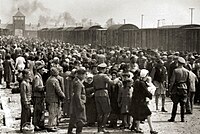
Photo from wikipedia
The transition of the memory of twentieth-century conflicts from survivor to cultural memory has become inevitable with the passing of the survivor generation. This article examines the role of different… Click to show full abstract
The transition of the memory of twentieth-century conflicts from survivor to cultural memory has become inevitable with the passing of the survivor generation. This article examines the role of different generations in the retrieval and commemoration of the traumatic past in Germany and Spain by focusing on two main areas: firstly, it analyzes the debates surrounding the Holocaust Memorial in Berlin and the ongoing review of form and function of existing memorial sites in the city, as well as ongoing vandalism and trivialization of these sites. Secondly, it examines recent debates and protests in Spain surrounding the 1977 Amnesty Law by prominent artists and the wider public. These range from protests against the indictment of Judge Baltasar Garzón in 2010 for opening an investigation into crimes against humanity committed by the Franco regime to demonstrations in November 2015 demanding an annulment of the 1977 Law, and to the recent Argentinean court case of Franco-era human rights crimes. Considering Pierre Nora’s notion that lieux de mémoire can be ‘material or non-material’, this article suggests that debates and demonstrations can act as a virtual space in which memory is viable. It analyzes the role of the ‘generations of postmemory’, in particular the third and fourth generations, in forestalling silence and forgetting and changing existing rigid discursive patterns.
Journal Title: Journal of Contemporary History
Year Published: 2017
Link to full text (if available)
Share on Social Media: Sign Up to like & get
recommendations!